teodor
National Hazard
   
Posts: 872
Registered: 28-6-2019
Location: Heerenveen
Member Is Offline
|
|
Trinitrotriamminecobalt - Co(NH3)3(NO2)3
This is "by far the most important starting material in the triamminecobalt series" as Inorganic Syntheses, Vol. VI says.
As far as I understand NO2- group could be exchanged for virtually any other group, so by reacting this material with acids it is possible to get
different complexes.
I followed the preparation from Inorganic Syntheses (1/2 scale), for your convenience I put it here.
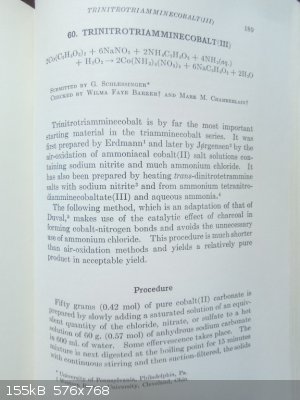 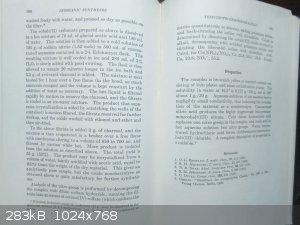
It is better to use freshly prepared Co(II) carbonate. Mine was prepared 3 months ago (by the reaction of Co(NO3)2*6H2O and K2CO3) and after this
period dissolution in hot acetic acid is quite slow and far from completion. But it is not a problem for the preparation - the suspension could be
used for the preparation, CoCO3 doesn't interfere with the reaction (except for forming some green compound on flask walls which will be filtered off
during the phase of hot filtration when the charcoal catalyst should be filtered-off).
I used a chemical pure Co source (bought from chemship1978):
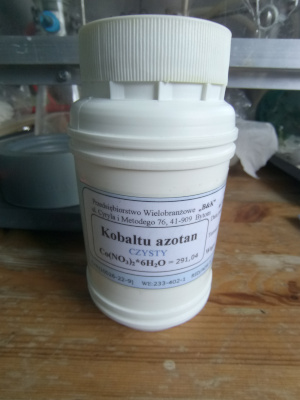
I have a pottery-grade carbonate too which could be converted to CoCl2 and back to carbonate (to make it fresh) for the preparation but the presence
of other transitional metals could puzzle me when I will want to study crystals under a microscope - I had already this experience with another Co
complex and now it is hard to say are the different forms of crystals the result of Ni impurities or they are isomeric forms of the compound.
And this experiment would not have been possible if woelen had not presented me this nice bottle:
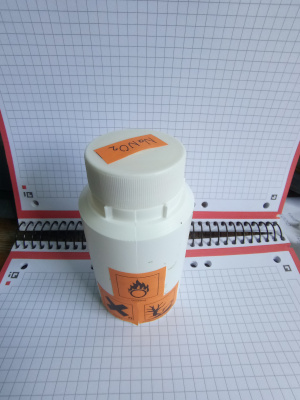
(OK, it is possible to make a nitrite by reducing a nitrate with lead, but I was lazy and woelen was generous. Woelen, now I can give Co(NH3)3(NO2)3
to you in exchange if you would like to make experiments with it).
I expected a change of the color during boiling with charcoal but actually mixing cold NaNO2 in NH3(aq) with hot Co(OAc)2 gives a solution with a
color of the tee. The addition of H2O2 makes this color only darker. And boiling with charcoal doesn't change the color at all.
At the end of the boiling all unreacted CoCO3 forms some green Co(III) compound which deposits on the flask walls (what it could be?).
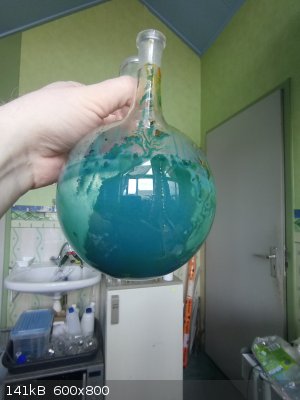
This is the first crop of crystals and the filtrate for the next boiling with charcoal (to get the second crop):
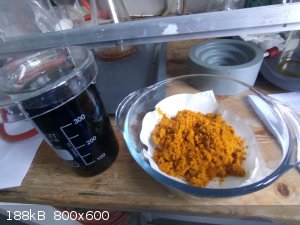
[Edited on 25-5-2022 by teodor]
|
|
|
clearly_not_atara
International Hazard
    
Posts: 2692
Registered: 3-11-2013
Member Is Offline
Mood: Big
|
|
| Quote: | | I expected a change of the color during boiling with charcoal but actually mixing cold NaNO2 in NH3(aq) with hot Co(OAc)2 gives a solution with a
color of the tee. The addition of H2O2 makes this color only darker. |
Well I'm awake now 
So this is a neutral, covalent complex? Does it dissolve in organic solvents?
...is it a primary? 
[Edited on 04-20-1969 by clearly_not_atara]
|
|
|
teodor
National Hazard
   
Posts: 872
Registered: 28-6-2019
Location: Heerenveen
Member Is Offline
|
|
Actually, I don't know whether the absence of conductivity of the aqueous solution is equivalent to being completely non-ionic. Still, logically, I
don't see how an ionic compound can be nonelectrolyte.
I will return after some time with more information about the compound properties.
|
|
|
clearly_not_atara
International Hazard
    
Posts: 2692
Registered: 3-11-2013
Member Is Offline
Mood: Big
|
|
https://pubs.acs.org/doi/pdf/10.1021/ja01457a005
"The results with trinitro-triammine cobalt are somewhat similar, but
very interesting. Slight evolution of gas begins at 158 C, but at 164 C
the decomposition takes place with almost explosive violence, forming
pure nitrogen, water and cobaltic oxide, according to the following re-
actions."
2 Co(NH3)3(NO2)3 >> Co2O3 + 9 H2O + 6 N2
[Edited on 04-20-1969 by clearly_not_atara]
|
|
|
DraconicAcid
International Hazard
    
Posts: 4278
Registered: 1-2-2013
Location: The tiniest college campus ever....
Member Is Offline
Mood: Semi-victorious.
|
|
Quote: Originally posted by teodor  | Actually, I don't know whether the absence of conductivity of the aqueous solution is equivalent to being completely non-ionic. Still, logically, I
don't see how an ionic compound can be nonelectrolyte.
I will return after some time with more information about the compound properties. |
It is a neutral molecule with non-labile covalent bonds. The bonds are really polar, though, so I doubt it would dissolve in organic solvents.
Please remember: "Filtrate" is not a verb.
Write up your lab reports the way your instructor wants them, not the way your ex-instructor wants them.
|
|
|
zed
International Hazard
    
Posts: 2277
Registered: 6-9-2008
Location: Great State of Jefferson, City of Portland
Member Is Offline
Mood: Semi-repentant Sith Lord
|
|
Ummm. Should this be posted in "Energetic Materials"?
Seems to me, that a similar material, severely injured a researcher, that was grinding the material (under liquid) using a mortar and pestle.
The researcher, thought that the presence of liquid, would protect against detonation.
The presence of liquid, did not prevent detonation.
|
|
|
teodor
National Hazard
   
Posts: 872
Registered: 28-6-2019
Location: Heerenveen
Member Is Offline
|
|
I already did a grinding of the well-dried material to a fine powder stirring it in a mortar. I did it because it was mentioned in the procedure of
some other complex preparation (the report will come soon). There was no remark about the danger of such an operation in the published procedure.
Also, I didn't get an issue.
I've tested the material in the flame of a teclu burner, it just burns. Look at the photo.
So, it is definitely not a good primary. The most interesting property of the material is being a starting material to synthesize other triamines of
cobalt. Probably, including primaries. But this topic is a wider one, I would dedicate it to cobalt triamines.
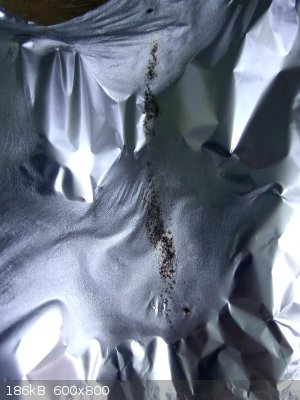
Update: I did a fire test with a bigger amount. It burns easily in flame but it doesn't burn outside of flame, so it looks like the decomposition
doesn't give enough energy to support burning by itself.
[Edited on 3-6-2022 by teodor]
|
|
|
teodor
National Hazard
   
Posts: 872
Registered: 28-6-2019
Location: Heerenveen
Member Is Offline
|
|
Dichrochloride
The full name of this compoud is "dichloroaquotriamminecobalt (III) chloride". "Dichrochloride" is for short.
Co(NH3)(NO2)3 + 3HCl + H2O -> [Co(NH3)3(H2O)Cl2]Cl + 3HNO2
2HNO2 + CO(NH2)2 -> CO2 + 2N2 + 3H2O
The conversion is driven by urea + NO2 decomposition but practically it can take several days (depending on the temperature control).
The procedure is described in Inorganic Syntheses', Vol. 6, number 57 (submitted by Gert G. Schlessinger).
I found some useful tips which I will document in the following posts.
The importance of Co(III) Dichrochloride is described by Gert Schlessinger in the following words:
"Dichrochloride serves as intermediate for the preparation of most water-soluble triamminecobalt compounds, which usually cannot be made from the
difficulty soluble trinitrotriamminecobalt".
On the photo: 10g of trinitrotriamminecobalt in the bottle (the starting compound) and the dichrochloride at the stage of air drying.
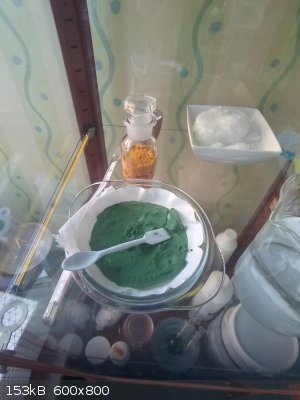
[Edited on 4-6-2022 by teodor]
|
|
|
teodor
National Hazard
   
Posts: 872
Registered: 28-6-2019
Location: Heerenveen
Member Is Offline
|
|
I found this survey of the explosive properties of cobalt complexes:
Attachment: tomlinson1949.pdf (273kB)
This file has been downloaded 158 times
I doubt it is the same trans-Co(NH3)3(NO2)3. I did the test with a hammer and it didn't explode. Probably the method of preparation plays some role.
Also, cis-Co(NH3)3(NO2)3 could be more sensitive. For the preparation look here:
Attachment: bcsj.13.450.pdf (3.4MB)
This file has been downloaded 143 times
And for the starting compound Co(NH3)3(NO3)3 one can use the procedure from Gmelin:
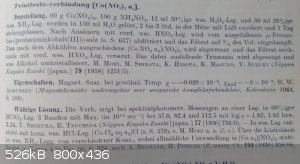
(In the first article another attractive Co complex was mentioned: tri-hydrazine cobalt(II) nitrate, I believe the formula is [Co(N2H4)3](NO3)2. It
could be an interesting beast).
But back to the topic. I promised to give my comments on the procedure of the dichrochloride preparation.
Attachment: img-220626133908.pdf (5.1MB)
This file has been downloaded 181 times
1. Before grinding Co(NH3)(NO2)3 in a mortar make sure your sample of the compound is not impact-sensitive (test it with a hammer).
2. Mixing of concentrated sulfuric and hydrochloric acid should be performed at the lowest temperature you can achieve. It warms during the mixing and
in my case, the temperature was around 7-10C which is quite high because some HCl was lost.
3. The rate of conversion probably is dependent on HCl concentration (which is dependent on step 2). In my case it took almost 3 days of stirring, but
also I was not able to control the temperature during the full process.
This is how the transformation looks like:
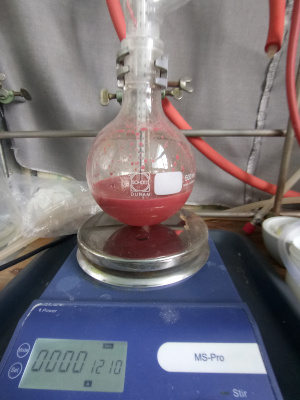 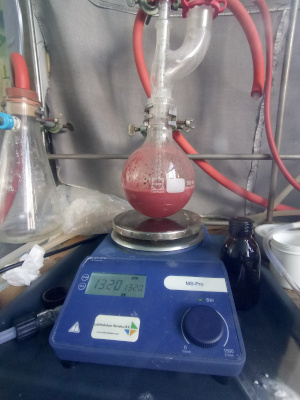 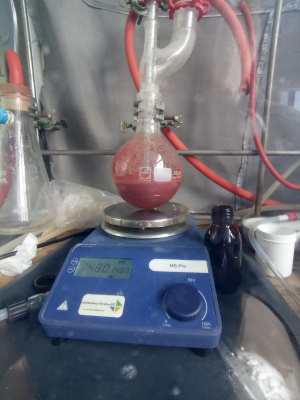 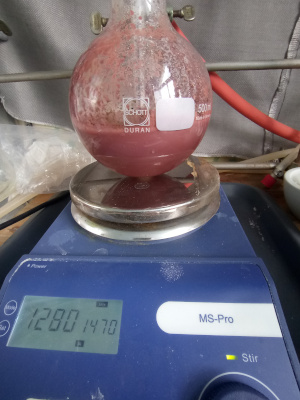 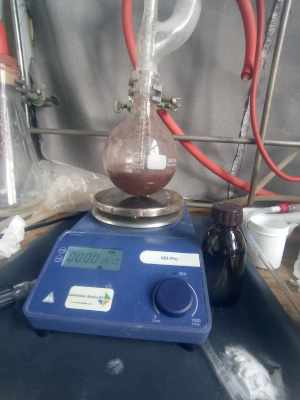 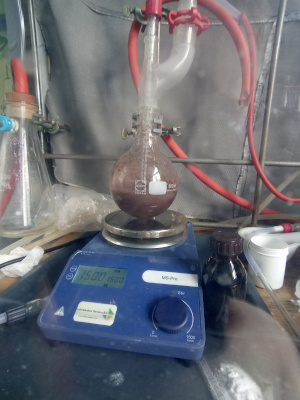 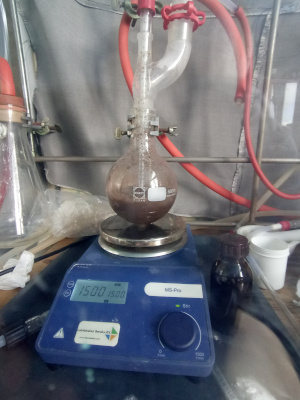 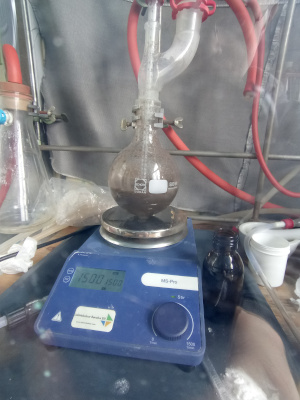 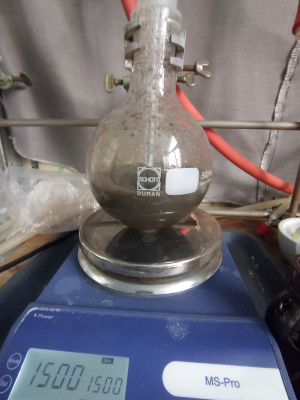 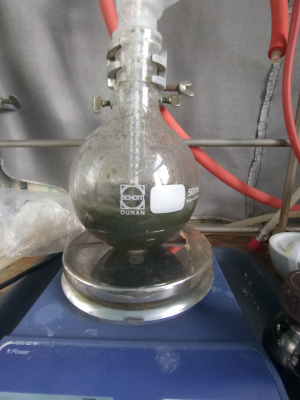 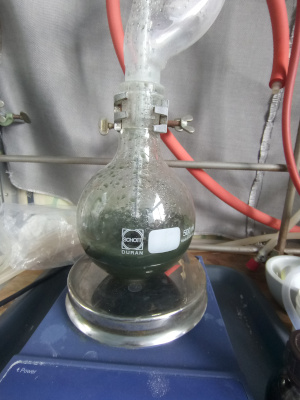 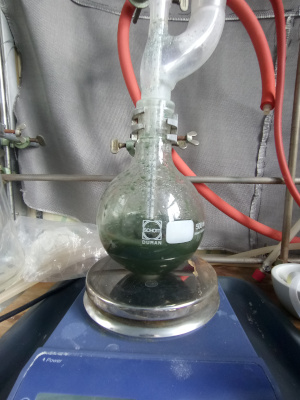 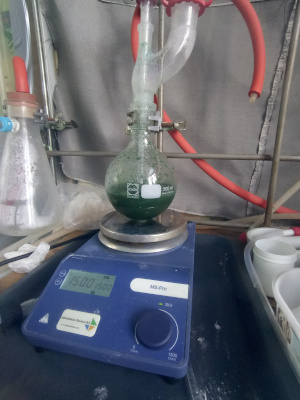 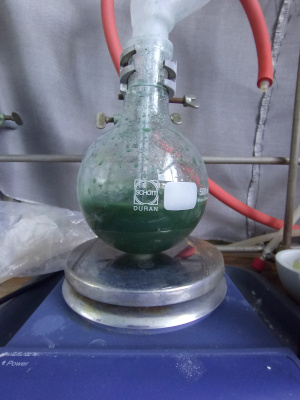 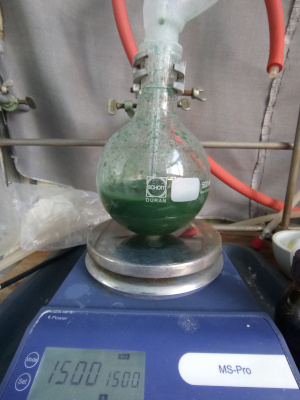
The source compound [Co(NH3)(NO2)3] and the result [Co(NH3)3(H2O)Cl2]Cl:
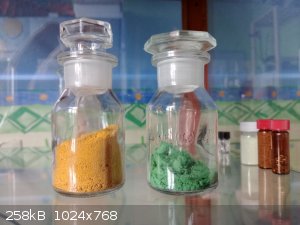
|
|
|